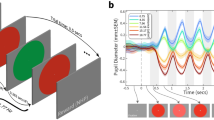Abstract
The pupil can be excited to sustained oscillations under high gain feedback conditions. The period of these oscillations (cycle time) is reduced by increased average light level by an amount commensurate with reductions in phase lag reported in the companion paper (Myers et al. 1991b). A mathematical model of this phenomenon is used to unify and clarify experimental data presented here and in the literature.
Similar content being viewed by others
References
Campbell FW, Whiteside TCD (1950) Induced pupillary oscillations. Br J Ophthalmol 34:180–189
Cox TA, Thompson HS, Hayreh SS, Snyder JE (1982) Visual evoked potential and pupillary signs: a comparison in optic nerve disease. Arch Ophthalmol 100:1603–1607
Longtin A, Milton JG (1989) Insight into the transfer function, gain and oscillation onset for the pupil light reflex using nonlinear delay differential equations. Biol Cybern 61:51–58
Miller SD, Thompson HS (1978a) Edge-light pupil cycle time. Br J Ophthalmol 62:495–500
Miller SD, Thompson HS (1978b) Pupil cycle time in optic neuritis. Am J Ophthalmol 85:635–642
Myers GA, Sherman KR, Stark L (1991) Eye monitor: microcomputer-based instrument uses an internal model to track the eye. Computer 24:14–21
Myers GA, Stark L (1993) Level dependent signal flow in the light pupil reflex: I Latency of time domain responses to transient stimuli. Biol Cybern 68:229–234
Myers GA, Gannon JA, Stark L (1993) Level dependent signal flow in the light pupil reflex: II. Phase velocity of responses to sinusoidal stimuli. Biol Cybern 68:235–240
Semmlow J, Hansmann D, Stark L (1974) Variation in pupillomotor responsiveness with mean pupil size. Vision Res 14:1–16
Stark L (1959) Stability, oscillations and noise in the human pupil servomechanism. Proc IRE 47:1925–1939
Stark L (1962) Environmental clamping of biological systems: Pupil servomechanism. JOSA 52:925–930
Stark L, Baker F (1959) Stability and oscillations in a neurological servomechanism. J Neurophysiol 22:156–164
Stern HJ (1944) A simple method for the early diagnosis of abnormality of the pupillary reaction. Br J Ophthalmol 28:275–276
Ukai K, Higashi JT, Ishikawa S (1980) Edge-Light pupil oscillation of optic neuritis. Neuroophthalmology 1:33–43
Usui S, and Stark L (1978) Sensory and motor mechanisms interact to control amplitude of pupil noise. Vision Res 18:505–507
Wybar KC (1952) Ocular manifestations of disseminated sclerosis. Proc R Soc Med 45:315–320
Weinstein JM, Van Gilder JC, Thompson HS (1980) Pupil cycle time in optic nerve compression. Am J Ophthalmol 89:263–267
Author information
Authors and Affiliations
Rights and permissions
About this article
Cite this article
Myers, G.A., Stark, L. Level dependent signal flow in the light pupil reflex. Biol. Cybern. 68, 241–246 (1993). https://doi.org/10.1007/BF00224858
Received:
Accepted:
Issue Date:
DOI: https://doi.org/10.1007/BF00224858




